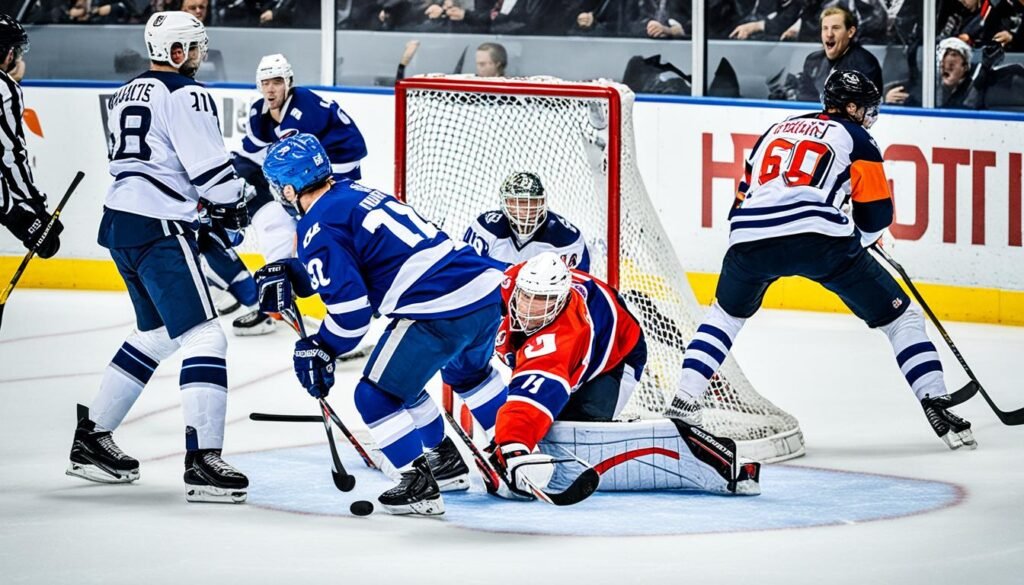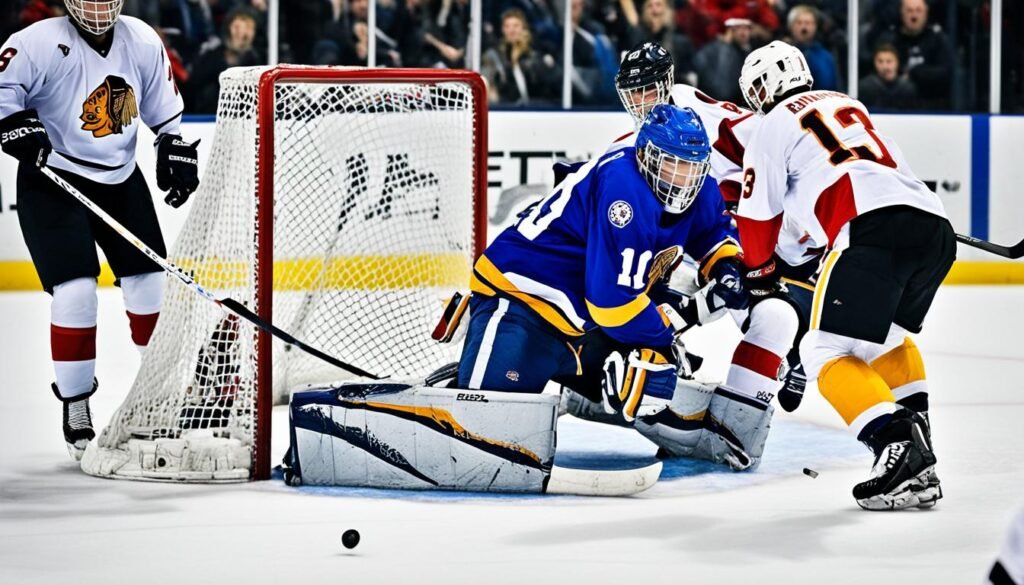When watching a hockey game, you may have noticed that penalties are an integral part of the sport. But do you know what those penalties mean and how they affect the game? Hockey PIM, or penalties in minutes, is a statistic that provides valuable insights into player behavior and team strategies.
Throughout this comprehensive guide, we will explore the role of PIM in understanding player discipline, the different types of penalties, and how they contribute to PIM. We will also delve into the significance of power plays and discuss the future of PIM in hockey. By the end, you’ll have a deep understanding of this vital statistic.
Key Takeaways:
- Hockey PIM measures the total amount of time a player has been penalized during a game.
- Different types of penalties, such as minor, major, and misconduct, contribute to a player’s PIM.
- PIM provides insights into a player’s discipline and can impact team strategies.
- Power plays occur when a team has a numerical advantage due to an opponent’s penalty.
- Understanding PIM and other hockey statistics enhances your enjoyment and appreciation of the sport.
What is Hockey PIM and its Role in Hockey?
PIM, which stands for “penalties in minutes,” is a statistical measure in hockey that tracks the total amount of time a player spends in the penalty box for committing infractions such as tripping, hooking, or fighting. It serves as a record of a player’s discipline or lack thereof and can provide valuable insights into their on-ice behavior. While avoiding penalties is important, strategic penalties can also be utilized to gain advantages during a game.

The Importance of PIM
In hockey, player discipline is essential for maintaining fair and respectful gameplay. PIM helps measure a player’s ability to adhere to the rules and regulations of the sport. It not only indicates their willingness to play within the boundaries of the game but also reflects their overall mindset and self-control on the ice.
Disciplined players with lower PIM demonstrate their focus on playing clean and avoiding unnecessary penalties that could put their team at a disadvantage. On the other hand, aggressive players who accumulate higher PIM may be viewed as more physically imposing and intimidating to opponents. Their presence can impact the momentum of a game and provide a psychological advantage for their team.
Strategic Penalties and Team Advantage
While undisciplined penalties can hurt a team, strategic penalties can sometimes be used to gain an advantage during a game. Players and coaches may strategically take penalties to prevent an opponent from scoring, break the rhythm of play, or provide enough time for teammates to rest and plan game strategies. These strategic penalties are carefully calculated to maximize the benefit for the team, even at the cost of spending time in the penalty box.
The Role of PIM in Team Dynamics
Player discipline and penalties in minutes can heavily influence team dynamics on and off the ice. Coaches often emphasize the importance of playing smart, disciplined hockey, as undisciplined play can lead to costly mistakes and create vulnerabilities for opponents to exploit. A team with low PIM indicates a strong focus on staying disciplined and maintaining composure, which can contribute to a more cohesive and successful team overall.
Conversely, a team with high PIM may struggle with maintaining control, leading to a more chaotic and unpredictable style of play. This can have both positive and negative effects, as it can intimidate opponents but also increase the risk of penalties that may put the team at a disadvantage.
The Future of PIM in Hockey
PIM has been a core statistic in hockey for decades, providing valuable insights into player discipline and team dynamics. However, as the sport evolves and new technologies emerge, the evaluation of player behavior may extend beyond PIM alone. Advanced analytics and tracking systems now allow for a more comprehensive understanding of player performance and behavior on the ice.
As the game continues to evolve, the role of PIM may adapt to better reflect the changing dynamics of the sport. New metrics and measurements may be introduced to provide a more nuanced assessment of player discipline and its impact on the game.
| Benefits of Low PIM | Advantages of High PIM |
|---|---|
| – Less time spent in the penalty box | – Physically intimidating opponents |
| – Demonstrates discipline and composure | – Can create a psychological advantage |
| – Minimizes the risk of putting the team at a disadvantage | – Can disrupt opponents’ game plans |
Types of Penalties and Their Impact on PIM
Hockey penalties come in various forms, each with its own severity and duration. Understanding the different penalty types is crucial for both players and fans alike. Let’s explore the three main types of penalties and how they contribute to a player’s Penalty in Minutes (PIM):
1. Minor Penalties
Minor penalties are typically given for less severe infractions that hinder the flow of the game. These penalties result in a two-minute time in the penalty box for the offending player. Common examples of minor penalties include tripping, hooking, and holding. While two minutes may not initially seem significant, it can have a considerable impact on the team’s dynamic and strategy.
2. Major Penalties
Major penalties are more severe and warrant a five-minute penalty. They are typically given for offenses such as fighting or deliberate acts of aggression. In addition to the longer penalty duration, major penalties can lead to ejections, suspensions, and fines. The impact of a major penalty can be significant, as it not only removes a player from the game for an extended period but also forces the team to play shorthanded.
3. Misconduct Penalties
Misconduct penalties are administered for serious offenses that go beyond the scope of minor and major penalties. These penalties result in a ten-minute penalty and often accompany an ejection from the game. Misconduct penalties can be given for actions such as inappropriate conduct, abuse of officials, or particularly dangerous plays. The extended penalty time can significantly affect a player’s ice time, as well as disrupt the team’s rhythm and strategy.
Each type of penalty contributes to a player’s PIM. The accumulation of penalties can lead to further consequences, such as suspensions or a reputation as an undisciplined player. It is essential for players to understand the severity and impact of each penalty type to make informed decisions on the ice.

| Penalty Type | Severity | Duration |
|---|---|---|
| Minor Penalty | Less severe | 2 minutes |
| Major Penalty | More severe | 5 minutes |
| Misconduct Penalty | Serious offenses | 10 minutes |
Penalties in Minutes (PIM) in the Context of the NHL
Within the NHL, PIM plays a crucial role in shaping player reputations and influencing team strategies. Throughout their careers, some players have established themselves as all-time PIM leaders, showcasing their aggressive playing style and unwavering loyalty to their teammates. Even renowned scorers like Wayne Gretzky have left a significant mark on the PIM records, evidencing their ability to balance aggression and skill on the ice. By delving into the expansive history of PIM in the NHL and exploring the unique records set by players, we gain a deeper understanding of the multifaceted role that PIM plays in professional hockey.
When it comes to NHL penalties, the all-time PIM leaders exhibit an elite level of physicality and determination. These players embody the essence of hockey’s unyielding spirit and showcase the effectiveness of controlled aggression in the game. By studying their records and analyzing their performances, we can gain invaluable insights into the impact of PIM on player behavior and team dynamics.
Wayne Gretzky, often celebrated as one of the greatest goal-scorers in NHL history, also left his mark on the PIM records. Despite his finesse and ability to dazzle with his skill, Gretzky wasn’t hesitant to engage physically when necessary. His notable PIM record serves as a reminder of his versatility and ability to adapt to different game situations, exemplifying the fine balance between skill and aggression.
Understanding the all-time PIM leaders and their unique records brings to light the intricate relationship between PIM, player style, and on-ice success. It sheds light on the role of physicality within the game and its impact on overall performance. By analyzing these records, players, coaches, and fans can further appreciate the significance of PIM in professional hockey, deepening their understanding of the sport’s complexity.
Power Plays and Special Hockey Terms
Power plays in hockey occur when one team has a numerical advantage due to an opponent being penalized. This creates an exciting opportunity for the team on the power play to take control of the game. Let’s explore some special hockey terms and statistics related to power plays that enhance our understanding of this crucial aspect of the game.
Power Play Goals
Power play goals are goals scored by a team while they have a numerical advantage due to a penalty against the opposing team. These goals can be pivotal in turning the tide of a game and often require intricate strategies and skilled execution. It’s a testament to a team’s offensive prowess and their ability to capitalize on the opponent’s penalty.
Shooting Percentage
Shooting percentage is a statistic that measures the efficiency of a player or team’s shots on goal. It is calculated by dividing the number of goals scored by the total number of shots taken and multiplying the result by 100. A high shooting percentage during power plays indicates accurate and effective shot selection, while a low shooting percentage may indicate missed opportunities or strong defensive play by the opposing team.
Plus-Minus Rating
Plus-minus rating is a statistic that measures a player’s impact on the game’s outcome while they are on the ice. It is calculated by recording the number of goals scored by a player’s team while they are on the ice (plus) and subtracting the number of goals scored by the opposing team while they are on the ice (minus). A positive plus-minus rating indicates that the player’s team has outscored the opponents while they are on the ice, highlighting their contribution to the team’s success during power plays and overall.
Understanding power plays and these special hockey terms allows us to appreciate the strategic elements of the game and the impact they have on team performance. Now, let’s take a closer look at some key power play statistics in the NHL.
| Team | Power Play Goals | Shooting Percentage | Plus-Minus Rating |
|---|---|---|---|
| Tampa Bay Lightning | 38 | 25.6% | +40 |
| Toronto Maple Leafs | 35 | 26.4% | +29 |
| Colorado Avalanche | 33 | 23.5% | +32 |
| Vegas Golden Knights | 31 | 21.7% | +31 |
| Carolina Hurricanes | 29 | 24.6% | +22 |
The table above showcases the power play performance of some top teams in the NHL. As you can see, different teams have varying power play goals, shooting percentages, and plus-minus ratings, highlighting the unique strategies and strengths of each team. These statistics provide valuable insights into a team’s ability to convert power play opportunities into goals and their overall effectiveness during this crucial phase of the game.
Conclusion
Hockey statistics are a vital aspect of understanding player performance and team dynamics. One key statistic that provides valuable insights is PIM, which measures a player’s penalties in minutes. By tracking a player’s discipline, PIM allows us to gauge their on-ice behavior and the impact it has on the game.
In addition to PIM, other statistics like power play goals and shooting percentage showcase a player’s skill and effectiveness during crucial moments in a game. These metrics contribute to a comprehensive understanding of a player’s overall performance and contribution to their team’s success.
Familiarizing yourself with hockey stats can greatly enhance your enjoyment and appreciation of the sport. By diving deeper into the numbers, you gain a deeper insight into the intricacies of the game and the strategies employed by teams and players.
While the future of PIM and potential changes to the system are uncertain, staying informed about the current landscape of hockey statistics is crucial. By understanding the evolving nature of these metrics, you can stay engaged with the sport and its ever-changing dynamics.







